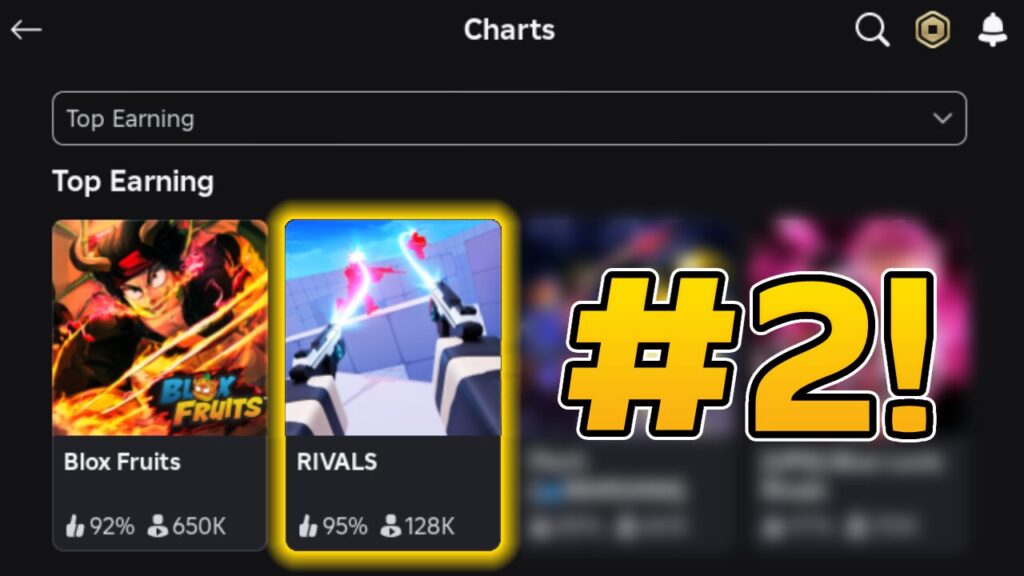
We’re going behind the scenes to uncover 10 key monetization strategies that have propelled Rivals to the #2 rank of the Top Earning chart on Roblox, and the design decisions that make these methods so effective.
We’ll explore how these strategies shape player behavior and the game’s community. You’ll also learn how features like public chest opening and gifting not only drive further spending, but also fuel social interaction and viral growth!
Whether you’re a creator looking to maximize the money your game makes, or just a curious player who wants to understand how Rivals became so successful, this video has something for you.
So let’s jump in..
#1. One-time purchase bundles
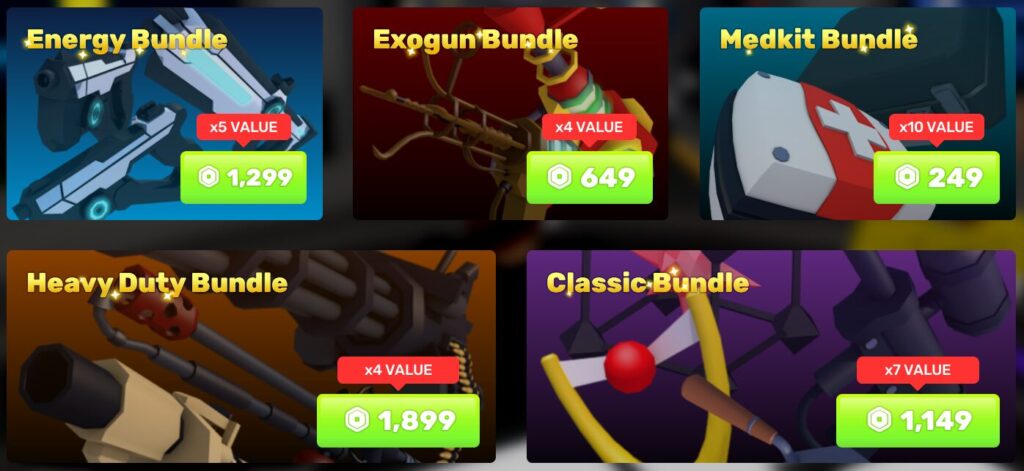
Rivals offers a range of one-time purchase bundles with prices spanning from 49 to 1,899 Robux. This wide price banding caters to different player spending preferences, from casual spenders to high rollers. The variety of price points makes the bundles feel accessible to a broad audience while still offering high-value options for big spenders.
Buying all these bundles together costs 7,181 Robux – roughly the same price as a full console game. This clever pricing strategy makes the bundles feel like a great value in comparison. Players may think, “For the price of one console game, I could unlock a treasure trove of exclusive items in my favorite Roblox game!” And when compared to the cost of unlocking all the same items just for Keys, you’re saving hundreds of dollars!
The bundles are also carefully crafted to minimize overlap and maximize desirability. With the exception of consumables like keys and chests, no items are duplicated across bundles. This means that collectors and completionists are compelled to purchase every bundle to own all the unique items.
#2. The Starter Bundle

Diving a bit deeper into the design of these bundles, the Starter Bundle in Rivals’ is a master class in driving first-time spending. At only 49 Robux, it’s an incredibly low barrier to entry for players who haven’t made any in-game purchases yet. But despite its low price point, the bundle packs a serious punch in terms of value.
Players get 12 times the value of the purchase price, including a weapon crate, both shotguns, 10 keys, and unlimited use of a legendary wrap, charm, and finisher. The sheer volume and rarity of these items makes the bundle feel like an absolute steal. Even hesitant spenders can easily rationalize the purchase as getting a massive discount.
Psychologically, once a player makes their first in-game purchase, they are far more likely to spend money again in the future. By making the starter bundle such an unbeatable deal, Rivals is essentially training players to become comfortable with spending Robux. It’s a key step in converting free-to-play users into paying customers.
#3. Standard Weapons Bundle
The standard weapons bundle in Rivals is designed to be a comprehensive solution for players who want to unlock all the base weapons at once. By purchasing the bundle, players get access to every current and future standard weapon in the game. This future-proofing is a strong incentive for players who want to stay competitive without worrying about grinding for new weapons.

But what really sets this bundle apart is its player-friendly refund system. If a player already owns some of the weapons in the bundle, they are automatically refunded the value of those weapons when they make the purchase. This ensures that players never feel punished for supporting the game early or for making individual weapon purchases before committing to the full bundle.
In addition to the weapons themselves, the bundle also includes exclusive unlimited-use items like a skin, wrap, and finisher. These bonus items add even more value to the bundle and give players a way to show off their status in-game.
#4. The Weapons List
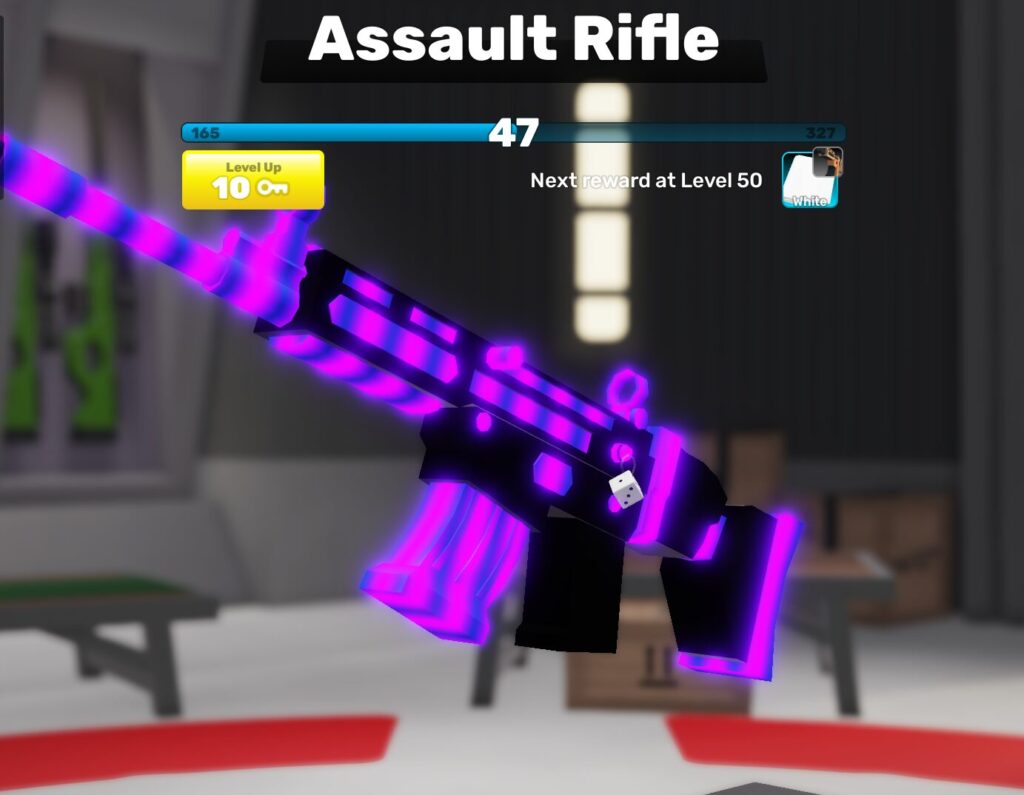
Rivals’ in-game weapons list UI is full of subtle but effective design choices that drive purchases. When a player highlights a locked weapon, the UI displays chains and locks around it.
Underneath each weapon, the UI displays a context-sensitive set of buttons to Unlock for Keys, Demo in the Shooting Range, or View Special Offers.
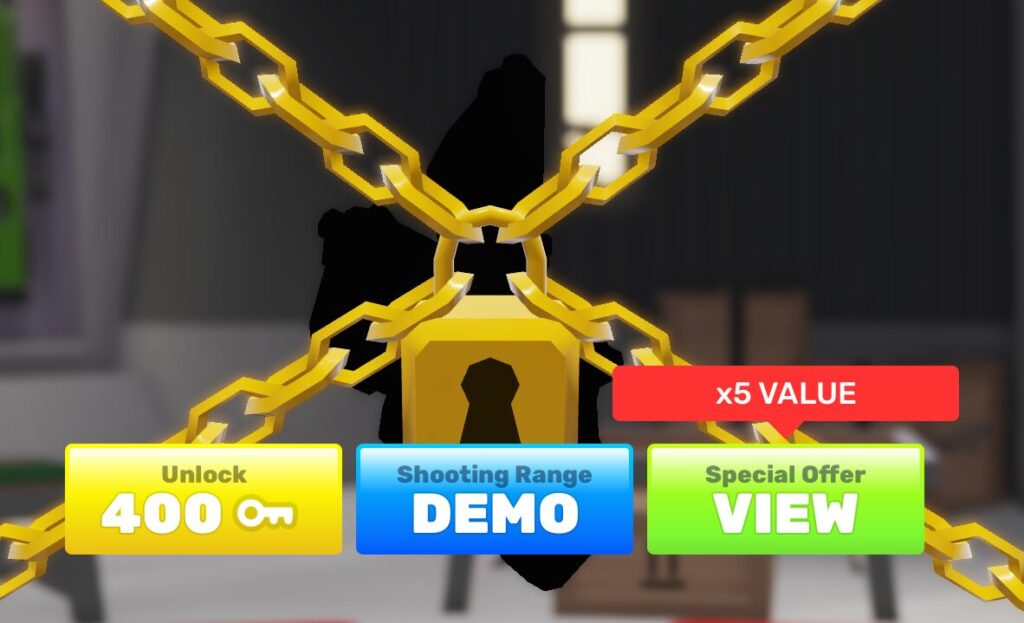
Key costs can range from as low as 10-15 for the Flare gun, Bow, or Chainsaw, and premium weapons like the Energy Pistols, Paintball Gun, and Medkit cost hundreds of keys each!
For all weapons, including the ones the player doesn’t own, the game encourages them to “Demo” in the shooting range. These point-of-interest links remove friction from the browsing-to-buying pipeline and push players to see how it feels before pulling the trigger on their purchase.
When a locked weapon is part of one of their bundles, players are also given the opportunity to buy it directly. This targeted messaging works to drive bundle purchases that could otherwise go unnoticed.
#5. Daily Deals
Rivals’ daily deal system is a master class in driving recurring engagement and purchase activity. Each day, the game offers a selection of discounted items like legendary skins, finishers, wraps, and charms, that are normally locked inside loot chests. This gives players a way to directly purchase skins and other cosmetics they want without relying on the randomness of loot boxes.

There’s also a free item in the Daily Deal list that refreshes daily. To claim the daily freebie, players have to come back to the shop every 24 hours. However, they can only claim the freebie if they already own the item it’s attached to. This limitation subtly encourages players to make additional purchases just to unlock their free loot. It’s an ingenious way to use a non-purchased reward to drive more spending.
The mere presence of the freebie item also makes players more likely to browse the full daily deal selection since they don’t know in what section or position it is going to appear. And once they’re already in the mental mode of shopping, players are more likely to be tempted into purchasing an actual discounted skin. It’s a multi-layered approach to guiding users towards purchase conversions.
Rivals also implemented a system to prevent players from exploiting the daily deal system. If players pay keys to reset their daily deals, the cost of keys increases each time until the day resets. By increasing the key costs, Rivals ensures that players can’t just spam the resets to get multiple free rewards in a single day. It forces players to engage with the game over a longer period of time if they want to maximize their free rewards. This approach also helps maintain the value of the rewards and prevents them from being too easily gamed.
#6. The Hub
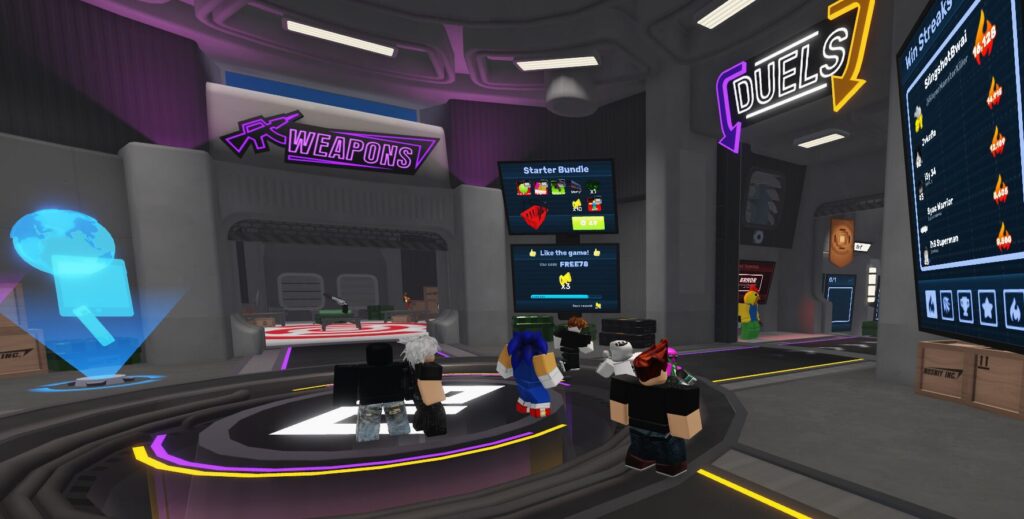
Rivals’ in-game hub area is designed to be a highly social space that also facilitates purchase activity. The hub includes designated areas for showing off new and featured weapons, skins, and other cosmetics. The hub’s shooting range allows players to test out all the weapons in the game, including those they haven’t unlocked yet. By giving players a taste of the weapons’ capabilities, the range serves as an interactive advertisement that encourages additional purchases.
But perhaps the most powerful driver of FOMO and spending in the hub is the public chest opening mechanic. When a player opens a loot chest, the items they win are broadcast to everyone else in the hub by default. This turns chest openings into high-visibility events that fuel envy and desire. Players who see others winning legendary items are strongly motivated to buy keys and chests in hopes of having their own lucky moment in the spotlight. In recent updates they even expanded how many chests you could open at once to maximize that great hit of dopamine from opening up to 8 at the same time, being showered in rewards!
Finally, Rivals places bundle advertisements in high-friction locations like the pre-match queue area for their Duel Arena mode. When players are hyped up and waiting to enter a match, they’re more likely to make impulse purchases. Catching players in these excited emotional states is a great way to lower their inhibitions and drive bundle sales.
#7. Pixel Skin Set
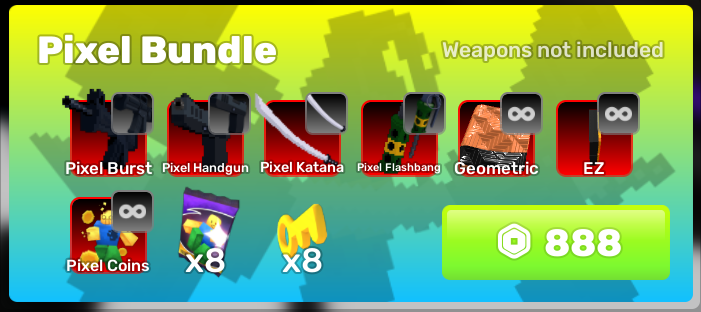
The pixel skin set in Rivals capitalizes on the collectible nature of exclusive cosmetics. To unlock the full set, players need to first own all the weapons associated with each skin. This requirement drives weapon sales and encourages players to make additional purchases beyond just the skins themselves.
The pixel skins are also strategically spread out across multiple areas of the shop, in Bundles, and in chests, rather than being sold together in a single set. This approach means that players need to buy the bundle and multiple chests to complete the collection, driving up the total cost of ownership.
Interestingly, the pixel skin bundle is priced at 888 Robux. In Chinese culture, the number 8 is considered lucky because it sounds similar to the word for “prosper” or “wealth”. By choosing this specific price point, Rivals is tapping into cultural symbolism and making the bundle feel fortuitous and special.
#8. Rotating Exclusives in Currency Bundles
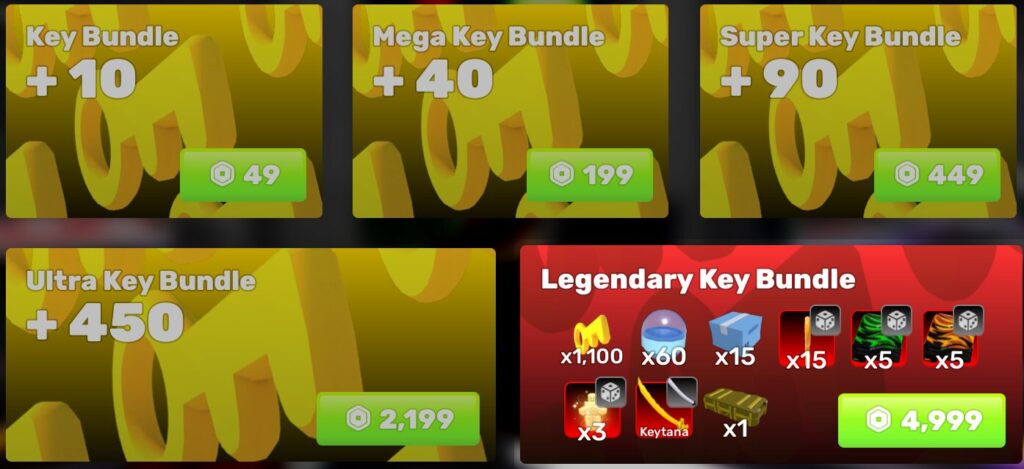
Rivals keeps players engaged and spending by including rotating exclusive items in their premium currency bundles. For example, the Legendary Key Bundle includes exclusive “gold key” items that can only be acquired by purchasing the bundle multiple times.
These exclusives prey on the “fear of missing out” (FOMO) and the completionist tendencies of hardcore collectors. To own every gold key item, players would need to buy the 4,999 Robux bundle every time it refreshes with new exclusives. This recurring spending trap is a reliable way to get revenue from a game’s most dedicated spenders.
#9. Random Assignment on Non-Robux Cosmetics

Another effective monetization trick is the random assignment for cosmetic items like wraps, charms, and finishers. When a player acquires one of these items for in-game currencies that aren’t Robux, it’s not immediately clear which weapon it will be assigned to. This uncertainty taps into our natural attraction to gambling and surprise rewards.
To ensure they can equip their favorite cosmetics on their preferred weapons, players are encouraged to make multiple purchases of loot chests. The more a player values a specific cosmetic or weapon combination, the more motivated they’ll be to keep rolling the dice.
This system also benefits from the sunk cost fallacy. Once a player has already acquired a few copies of a desirable cosmetic, they may feel compelled to keep buying chests until they finally get the one they’re looking for. It’s a powerful psychological trap that can keep the revenue flowing.
#10. Gifting

Rivals’ gifting system adds a social component to the in-game economy that many games fail to capitalize on. By letting players buy items and bundles for each other directly, Rivals encourages friends to spend money on each other’s behalf. When a player receives an exciting gift, they may be more motivated to return the favor, creating a reciprocal spending loop.
Gifting also enables Rivals creators and influencers to run item giveaways for their viewers and fans. These socially driven key giveaways bring more players into the game, boost overall community engagement, and generate free marketing on social media platforms. Recipients of the gift items may then be inspired to purchase additional keys and cosmetics to keep up their collection.
In a recent update, the team expanded support for gifting by allowing players to send 3 gift boxes at a time instead of just 1! This furthered the amount of Robux players could spend gifting things to each other.
Wrap-Up
From its one-time purchase bundles to its social chest openings, Rivals is a masterclass in designing monetization systems that engage and motivate players to spend. By analyzing these key strategies, we can gain a deeper understanding of how to create compelling, profitable Roblox experiences.
The through line in all of Rivals’ monetization features is a deep understanding of player psychology. Whether it’s capitalizing on the endowed progress effect with weapon bundles, leveraging collectors’ completionist instincts with exclusive skins, or using visual effects to make purchased items feel more valuable, every element of the Rivals economy is fine-tuned to maximize conversion and revenue.
But beyond just driving short-term purchases, Rivals’ monetization strategy also fosters long-term engagement and social interaction. Daily deals and frequent content updates keep players logging in regularly, while public chest openings in the hub world turn shopping into a form of exciting, rewarding entertainment. Rivals is a prime example of how thoughtful game design and smart monetization can combine to create a thriving, sustainable virtual economy.
So, what can other Roblox developers learn from Rivals’ success? Perhaps the biggest takeaway is to always put the player experience first. By ensuring that every monetized element in the game feels fair, rewarding, and genuinely fun, Rivals has built an audience that loves to support the game financially. And when creators respect their players’ time and intelligence, who knows what is possible.
